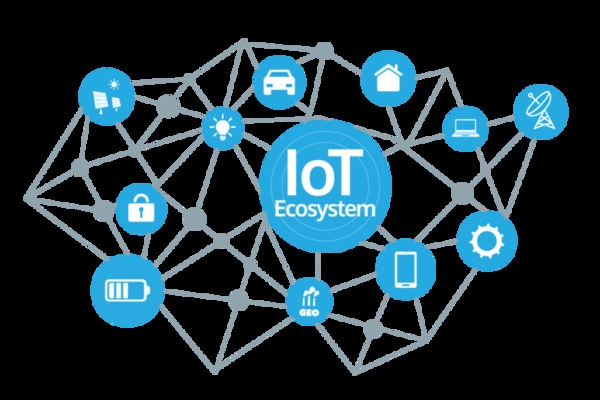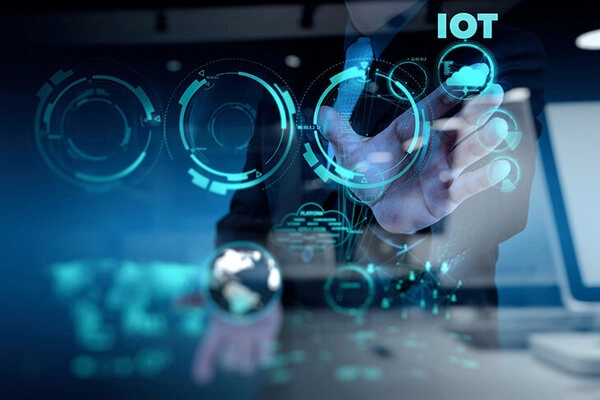In the era of Industry 4.0, the IoT ecosystem is becoming a key factor that helps businesses connect devices, collect data, and optimize their operational workflows. From manufacturing and workforce management to customer service, the IoT ecosystem enables intelligent monitoring, data-driven decision-making, and comprehensive improvements in business performance.
What is an IoT Ecosystem?
An IoT ecosystem is a complex network consisting of smart devices, sensors, data-processing platforms, network connectivity, and end users. This ecosystem not only allows devices to communicate with one another but also enables the intelligent collection, analysis, and utilization of data – helping businesses optimize operations and make informed decisions. With an IoT ecosystem, organizations can transform data into a competitive advantage, enhance operational efficiency, and deliver a better customer experience.

An IoT ecosystem operates effectively through the coordination of multiple components, each playing a crucial role – from data collection and information transmission to processing, security, and interaction with end users. Understanding these core components helps businesses build and maintain a stable and efficient IoT ecosystem.
Key Components of an IoT Ecosystem
An IoT ecosystem consists of several tightly connected elements, each responsible for an essential function within the overall system. Below are the fundamental components:

IoT Devices
IoT devices are hardware components capable of collecting data from their surroundings, such as sensors, industrial machines, smart wearables, or household devices. They act as the “eyes and ears” of the IoT ecosystem, enabling businesses to capture accurate data about operations and the environment.
Network Connectivity
Network connectivity is the infrastructure that transmits data from IoT devices to central processing systems. Common network technologies include Wi-Fi, Zigbee, LoRaWAN, 5G, and NB-IoT. The quality of the connection determines the speed, reliability, and security of data across the entire IoT ecosystem.
Gateway – Data Connectivity Hub
A gateway is an intermediary component that connects IoT devices to cloud computing platforms or data analytics systems. It processes raw data, filters out unnecessary information, and protects the internal network from security threats, ensuring that data moves safely and efficiently from devices to the cloud.
Cloud Platform
The cloud platform is where data collected from IoT devices is stored and processed. It provides big data analytics, flexible storage, and remote access. With cloud computing, businesses can deploy large-scale IoT applications without the need to heavily invest in physical infrastructure.
Security in the IoT Ecosystem
Security is a critical element of any IoT ecosystem. Data collected from IoT devices is often sensitive and closely tied to business operations. Security measures such as data encryption, multi-layer authentication, and access control help prevent cyberattacks and ensure safe ecosystem operation.
Applications and Control Platforms
Applications and control platforms are software tools used to manage, monitor, and optimize IoT devices. They provide intuitive interfaces for administrators, allowing them to schedule operations, perform remote control, analyze data, and receive alerts when issues occur. These platforms serve as the bridge between raw data and intelligent business decisions.
End Users
End users in an IoT ecosystem include employees, managers, customers, or anyone who interacts with IoT devices and applications. They are the ones who directly benefit from the system – whether through optimized workflows or enhanced customer experiences.
Benefits of an IoT Ecosystem for Businesses
An IoT ecosystem offers numerous advantages for businesses, from improving operations and increasing productivity to optimizing costs and enabling accurate, data-driven decisions.

- Improved Operational Efficiency: Businesses can monitor equipment and processes in real time. Early detection of issues, proactive maintenance, and automation help reduce errors while saving time and operational costs.
- Data-Driven Decision-Making: Real-time data from the IoT ecosystem enables leaders to make accurate decisions, optimize workflows, and develop strategies based on actual insights rather than assumptions.
- Cost and Resource Savings: The IoT ecosystem helps minimize energy waste, material loss, and unnecessary maintenance, improving overall performance and reducing operational risks.
Applications of the IoT Ecosystem in Workforce Management and Operations
Beyond production and equipment management, the IoT ecosystem delivers significant value in HR and workforce operations. IoT devices and platforms support performance monitoring, health tracking, working condition management, and resource optimization.
- Performance Monitoring: IoT wearables track employees’ health, working hours, and productivity, allowing businesses to evaluate performance more accurately.
- Optimized Scheduling: Based on real-time data, IoT systems can recommend optimal workforce allocation, preventing overload or understaffing.
- Workplace Safety: IoT sensors in hazardous environments provide early warnings of risks, helping reduce accidents and protect employee well-being.
Challenges in Implementing an IoT Ecosystem
Despite its advantages, deploying an IoT ecosystem still presents challenges related to costs, security, and data management.

- High Investment Costs: Businesses must purchase devices, build network infrastructure, and implement cloud platforms, which creates significant financial pressure – especially for small and medium-sized enterprises.
- Security and Data Management: IoT data is highly sensitive, involving production processes, employees, and customers. Protecting this data from cyberattacks, leaks, and unauthorized access is a major challenge. At the same time, managing large volumes of data from multiple devices requires a powerful and reliable system.
- Integration and Standardization: An IoT ecosystem consists of various types of devices and platforms. Connecting and standardizing data from different sources requires open, highly compatible solutions to ensure smooth and stable ecosystem operation.
Solutions for Building an Effective IoT Ecosystem
To successfully implement an IoT ecosystem, businesses need a synchronized approach – from choosing the right devices to ensuring security, data analytics, and employee training.
- Choosing Compatible Devices and Platforms: Selecting devices and platforms that support common protocols and are easy to integrate and expand helps reduce deployment costs and ensures long-term stability for the IoT ecosystem.
- Investing in Comprehensive Security: Security must be built in from the design stage. Measures such as data encryption, multi-layer authentication, access control, and regular firmware updates help reduce the risk of data loss and protect the entire IoT ecosystem.
- Leveraging Data Analytics and AI: Combining the IoT ecosystem with AI and data analytics enables businesses to extract insights from large data volumes, predict trends, generate early warnings, and make accurate decisions.
- Training Staff and Managing Change: Employees need proper training to use IoT devices and platforms effectively. Businesses must also manage operational changes to maximize the benefits of their IoT ecosystem.
Examples of Companies That Have Successfully Implemented an IoT Ecosystem
Many major enterprises have successfully adopted IoT ecosystems, demonstrating their practical value and impact across various industries.

- Siemens: Siemens applies its IoT ecosystem in smart manufacturing by using sensors and connected devices to monitor production lines, optimize productivity, and implement predictive maintenance – significantly reducing downtime.
- Amazon: Amazon deploys its IoT ecosystem across warehouse operations and delivery systems. Robots, sensors, and automated management platforms help track inventory, minimize errors, speed up order processing, and improve overall customer experience.
- Bosch: Bosch leverages its IoT ecosystem in both home appliances and industrial manufacturing. Its sensor systems and control platforms enhance operational efficiency, improve energy management, and deliver better user experiences.
These examples illustrate how building a robust IoT ecosystem enables businesses not only to operate more intelligently but also to strengthen their competitive advantage in the market.
The IoT ecosystem is more than just a network of connected devices – it is a strategic foundation that helps businesses optimize processes, improve operational efficiency, and make smarter data-driven decisions. Adopting an IoT ecosystem brings long-term benefits, from reducing costs and managing human resources more effectively to enhancing customer experiences, ultimately creating a sustainable competitive edge.
